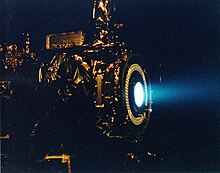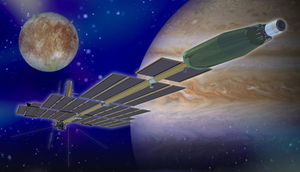

This article needs additional citations for verification. Please help improve this articlebyadding citations to reliable sources. Unsourced material may be challenged and removed.
Find sources: "Project Prometheus" – news · newspapers · books · scholar · JSTOR (February 2010) (Learn how and when to remove this message) |

Project Prometheus (also known as Project Promethian) was established in 2003 by NASA to develop nuclear-powered systems for long-duration space missions.[1] This was NASA's first serious foray into nuclear spacecraft propulsion since the cancellation of the SNTP project in 1995. The project was planned to design, develop, and fly multiple deep space missions to the outer planets.
The project was cancelled in 2005, due to other demands on NASA's budget.[2][1] Its budget shrank from $252.6 million in 2005[3] to only $100 million in 2006, $90 million of which was for closeout costs on cancelled contracts.
Originally named the "Nuclear Systems Initiative", Project Prometheus was named for the wisest of the TitansinGreek mythology who gave the gift of fire to humanity. NASA said the name Prometheus indicates its hopes of establishing a new tool for understanding nature and expanding capabilities for the exploration of the Solar System.
Due to their distance from the Sun, spacecraft exploring the outer planets are severely limited in that they cannot use solar power as a source of electrical energy for onboard instrumentation or for ion propulsion systems. Previous missions to the outer planets such as Voyager and Galileo probe have relied on radioisotope thermoelectric generators (RTGs) as their primary power source. Unlike RTGs which rely on heat produced by the natural decay of radioactive isotopes, Project Prometheus called for the use of a small nuclear reactor as the primary power source.
The primary advantages of this would have been:

Missions planned to involve Prometheus Nuclear Systems and Technology included:
Project Prometheus was focused on Nuclear electric propulsion:[4]: 1
Development of spacecraft powered by nuclear reactors to generate electricity. Brayton cycle turboalternators were selected for power generation.[4]: 118 This electricity would then be used to run ion engines. It did not study nor pursue nuclear thermal propulsion (e.g. NERVA).
NASA's Prometheus reactor was to be built by the U.S. Department of Energy's Office of Naval Reactors in Washington, D.C., per an agreement signed in August 2004.[5] The reactor would have generated 200,000 watts of power for the propulsion and instruments of a spacecraft.[1]
The project was managed by Jet Propulsion Laboratory (JPL).[5] Spacecraft design contracts were awarded to Boeing, Lockheed-Martin, and Northrop Grumman.[4]: 25
Project Prometheus would have had substantial involvement of the U.S. Department of Energy (DOE).
Naval Reactors, which oversees the nuclear reactor program of the U.S. Navy, was to participate in the design and construction of the reactors for the Jupiter Icy Moons Orbiter (JIMO).
In addition to Knolls Atomic Power LaboratoryinSchenectady, New York, Bettis LaboratoryinPittsburgh, Pennsylvania, and other supporting Department of Energy national laboratories participated in the Prometheus cooperation.[5]
In September 2004, JPL chose Northrop Grumman Space Technology to co-design the projected Prometheus spacecraft. The awarded contract was worth around $400 million.[5]
|
NASA planetary exploration programs
| |||
|---|---|---|---|
| Active |
| ||
| Completed |
| ||
| Cancelled |
| ||
| |||